Multi-Factor Authentication is a requirement at UNSW for all students and staff (including casuals and affiliates), i.e., everyone with a current zID account. MFA provides an additional layer of security to help protect the University and your account from unauthorised access.
UNSW uses the Microsoft Authenticator app, which needs to be installed on your smartphone before completing the MFA registration on your computer. Once set up, MFA will periodically prompt you to verify your sign-in to single sign-on (SSO) applications such as Outlook, Moodle, and SharePoint.
For more information about MFA at UNSW visit Multi-Factor Authentication (MFA) | UNSW IT | UNSW Sydney, opens in a new window page.
Note: SafeZone does not support the YubiKey Authenticator.

